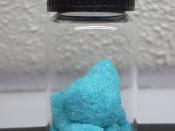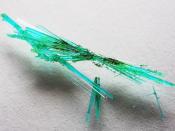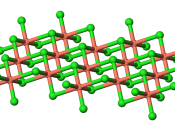Purpose: By doing this lab we were going were trying to determine a couple things. What we were trying to determine was the amount of moles of copper and the amount of moles of iron in the chloride and in the nail.
Procedure: 1. Put on your laboratory apron and safety goggles. Use a 100-mL beaker to make a solution with 2 grams of copper(II) chloride and 15-mL of distilled water.
2. Use a stirring rod to make sure all of the copper(II) chloride crystals have dissolved.
3. Obtain two clean, dry nails. Use a piece of sandpaper or emery cloth to shine the nails. Make sure that the nails can rest on the bottom of the beaker.
4. Place the nails in the copper(II) chloride solution. Leave the nails alone for approximately 20 minutes. During that time, you should see the formation of copper in the beaker. At the same time, some of the iron will react.
5. Use tongs to pick up the nails, one at a time. Use the wash bottle to rinse any remaining copper from the nails before removing them completely. Set nails aside.
6. Decant the liquid from the solid. Put the liquid into another beaker so if some solid comes out you can get it back.
7. Rinse the solid again with about 15-mL of distilled water. Decant again. Repeat this 3 times.
8. Wash the solid with 10-mL of 1M hydrochloric acid. Then decant. Wash again with 15-mL of distilled water and decant.
9. Place the beaker with the copper in a drying oven. Make sure the beaker had identification on it so you can get it the next day.
10. Clean up all materials and wash hands thoroughly.
Data: -Mass of the nail before put into solution = 2.87 grams.
-Mass of the nail after the copper chloride solution = 2.21 grams of Iron. Difference of = .66 grams of copper. From the nail there was .66 grams of copper and 2.21 grams of Iron.
-In moles; Copper: .66g x 1 mol/63.5g = .01 moles of Copper. (Solving: Take the amount of the remaining copper from the nail, .66 grams, and multiply that by 1 mol over the molar mass of copper, 63.5 grams. Your grams cancel out, so you solve and get .01 moles.) -For the mole of Iron; 2.21g x 1 mol/55.8g = .04 moles of Iron. (Solving: You solve it the same way that you would solve the above equation only with Iron's molar mass.) Conclusion There are about .01 moles in the copper from the nail. I observed the copper being broken away from the nail and the different color change in the nail. It turned to a copper looking color. There were little air bubbles all over the nail. For the iron, there were about .03 grams of iron in the nail. The copper and the iron different in moles and mass. The form of chloride that was made is FeCl2.
Theory: The mole is a standard measurement of how much of a substance there is. The theory that the number of formula units in a given substance is equal to the amount of formula units in 0.012 kilograms of Carbon is related to everything. So 12 grams of Carbon has 6.02 times 10^23 formula units. A mole's mass is the same as the atomic mass of the element it that is being used in the problem. A scientist came up with the number 6.02 x 10^23 formula units. The name, Avagadro's number came from this. The label of formula units can be said in a number of different ways. Just a couple ways you could label them are, atoms or particles. Depending on the situation, almost any label can be used. The mass of a mole never changes though. Every mole has a mass of 6.02 times 10^23. That is the theory of the mole. (www.avogadro.co.uk/chemist.htm)(www.chemistry.org) Evaluation: At the end of the experiment, my lab partners and I were able to determine the amount of moles of copper and the amount of moles of iron in copper chloride and a nail.



Happy
agreed :)
1 out of 2 people found this comment useful.